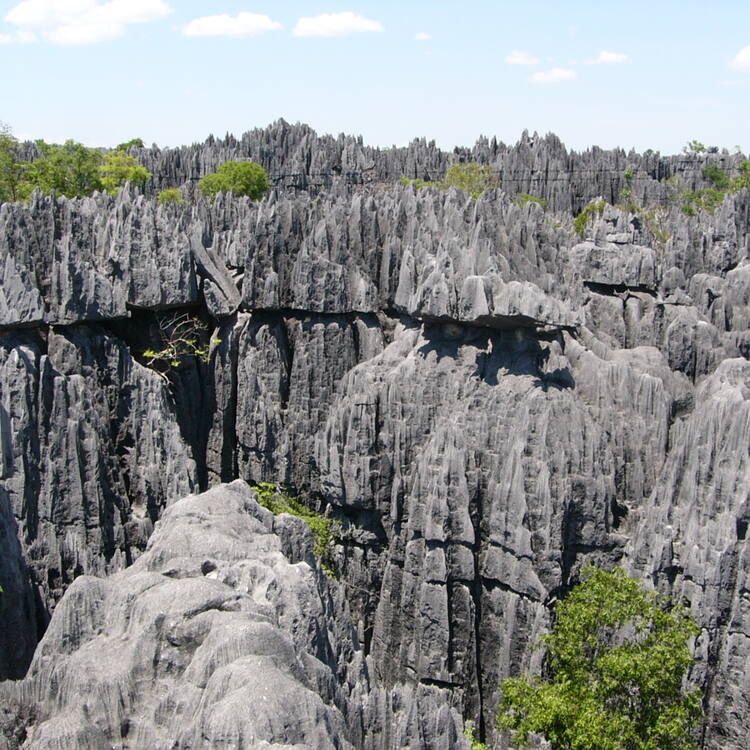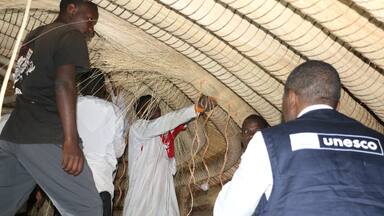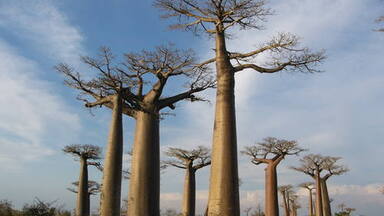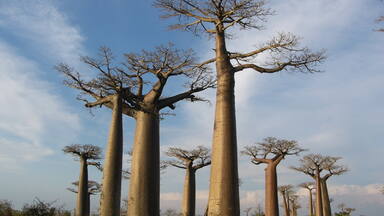Andrefana Dry Forests
Andrefana Dry Forests
This serial property in western Madagascar comprises karstic landscapes and limestone uplands cut into impressive 'tsingy' peaks and a 'forest' of limestone needles, the spectacular canyon of the Manambolo river, rolling hills and high peaks. Undisturbed forests, lakes and mangrove swamps are the habitat for rare and endangered lemurs and birds. The component parts of the property cover almost the full range of ecological and evolutionary variation within the western forests of Madagascar, including western dry forests and southwestern spiny forest-thicket. These sites contain a spectacular array of endemic and threatened biodiversity, including baobabs, flame trees (Delonix), as well as unique evolutionary lineages such as the Mesitornithiformes, an order of birds which is 54 million years old.
Description is available under license CC-BY-SA IGO 3.0
Les forêts sèches de l’Andrefana
Ce bien en série situé dans l'ouest de Madagascar comprend des paysages karstiques et des hautes terres calcaires découpées en impressionnants pics « tsingy » et une « forêt » d'aiguilles calcaires, le canyon spectaculaire de la rivière Manambolo, des collines ondulantes et de hauts sommets. Des forêts intactes, des lacs et des mangroves sont l'habitat de lémuriens et d'oiseaux rares et menacés. Les éléments constitutifs du bien couvrent presque toute la gamme des variations écologiques et évolutives au sein des forêts occidentales de Madagascar, y compris les forêts sèches occidentales et le bosquet forestier épineux du sud-ouest. Ces sites abritent un éventail spectaculaire de biodiversité endémique et menacée, notamment des baobabs, des arbres à flamme (Delonix), ainsi que des lignées évolutives uniques telles que les Mesitornithiformes, un ordre d'oiseaux vieux de 54 millions d'années.
Description is available under license CC-BY-SA IGO 3.0
غابات أندرفانا الجافة [توسيع مساحة
source: UNESCO/CPE
Description is available under license CC-BY-SA IGO 3.0
安德列发那干旱森林
source: UNESCO/CPE
Description is available under license CC-BY-SA IGO 3.0
Сухие леса Андрефана
source: UNESCO/CPE
Description is available under license CC-BY-SA IGO 3.0
Bosques secos de Andrefana
source: UNESCO/CPE
Description is available under license CC-BY-SA IGO 3.0
Outstanding Universal Value
Brief synthesis
The Andrefana Dry Forests serial property involves four national parks – Ankarafantsika, Mikea, Tsingy de Bemaraha and Tsimanampesotse – and two special reserves – Analamerana and Ankarana. The property represents centres of endemism in the dry tropical and subtropical biomes of Madagascar with its western dry forests and south-western dry thorny forests and thickets that have evolved in isolation on a large, massive island separated from all other land for tens of millions of years. The parks and reserves comprising the property provide a continuum of dry to arid forest formations from north to south, including almost all of the dry forest centres of endemism in western Madagascar. These centres of endemism evolved in isolation as a result of geographic barriers formed by major river systems, and as a result of paleoclimatic changes over millions of years, where changing rainfall patterns led to expansion and contraction of forest ecosystems. The property represents and conserves globally unique ecosystems, habitats and species. Madagascar’s long isolation has contributed to the development of a natural laboratory of evolution marked by exceptional biological diversity, one of the highest rates of endemism in the world, and a large number of ancient lineages that have disappeared elsewhere, such as the endemic order of mesites which are about 54 million years old. The Andrefana Dry Forests are essential for the protection of the island’s endemic ecosystems and biodiversity, as well as the diversity of evolutionary, ecological and biogeographic systems that have developed in Madagascar.
Criterion (vii): The Tsingy de Bemaraha Strict Nature Reserve, which has since become a National Park, represents rare or highly remarkable geological phenomena of exceptional beauty. It presents impressive geological elements including karstic scenery with a highly dissected limestone massif, crossed by a deep river gorge, which is the spectacular expression of a stage of evolution of the earth in the form of a “forest of sharp stones” with high limestone pinnacles rising up to 100 metres, forming veritable cathedrals, offering a grandiose, spectacular natural landscape. Further, “the Tsingy” of the limestone plateau forms an unusual feature of outstanding beauty, unique in the world, universally recognized by the effect created by the shades of forest green on metallic reflections of the grey karst “bristles”. While not adding additional attributes, the other five component parts of this serial property contribute to the overall natural beauty of the property.
Criterion (ix): The palaeoclimatic oscillations of the last few million years have had a profound effect on the landscapes and the evolution of the fauna and flora of Madagascar. The Andrefana Dry Forests are a complex product of this process. They have retreated during dry periods; they have expanded during wet periods but with variations deeply linked to the relief with its hydrological network. The centres of endemism that are home to many endemic species and higher taxa are the “interfluves” of the great rivers that have their sources on the highest peaks of Madagascar. The centres of endemism on the western slopes were refugia that captured parts of the hydrological system, allowing animal and plant populations to survive in isolation during dry periods. The Andrefana Dry Forests are distributed over all but one of the western endemic centres. Namely from south to north in the serial property, the endemism centres of Karimbola (Tsimanampesotse National Park), Mikea (Mikea National Park), Melaky (Bemaraha National Park), Sofia (Ankarafantsika National Park), Ankarana (Ankarana Special Reserve) and Vohimarina (Analamerana Special Reserve).
Criterion (x): Madagascar’s different forest types are home to 80% of its endemic species, and the dry forests make a major contribution to this richness. The dry forests are clearly distinct from the humid forests of Madagascar with flagship groups entirely restricted to dry formations such as baobabs, most members of the family Didiereaceae, flamboyant trees, mammals, birds, reptiles, amphibians, tortoises and more than half of the scorpions. Important species also include the Perrier’s Sifaka, and the Mongoose Lemur, the Madagascar Fish Eagle and the Western Woolly Lemur. Within the orders and families endemic to Madagascar, many genera and species are found only in dry forests or thorny thickets. Even more notable are the ancient orders of fauna that are endemic to the island, such as the two endemic birds of Mikea, named after a centre of endemism and a cultural group. The presence of endemic genera, and even families of vertebrates, many of them containing species that are highly threatened, in the component parts added in 2023 is unique among dry forests of the world. The additions also include almost one thousand endemic species and sub-species of plants, 156 endemic reptiles, 57 endemic mammals and 34 endemic amphibians.
Integrity
The size of the serial property and its buffer zone, the strict protection status of its component parts, and the north-south continuum they provide, ensure a strong basis for its Outstanding Universal Value. The size of the northern reserves is relatively small, but they are set in a local geographical context and their integrity is enhanced by the dry forests of the Andrafiamena-Andavakoera Reserve (IUCN category V) which links the two reserves. The Andrefana Dry Forests serial property includes all the elements necessary for the inclusion of key aspects of the processes essential for the long-term conservation of the ecosystems and the biological diversity they contain. Its component parts represent a series of unique centres of micro-endemism. Each of the property’s component parts has pursued a distinct but circumscribed history through the paleoclimatic oscillations of the Quaternary and earlier periods; this history, set in geological time, has had a determining impact on the groups of flora and fauna observed today and has directed evolution in many groups. Each nominated area contains those habitats that maintain the maximum animal and plant diversity that are characteristic of the centres of endemism in which biodiversity is embedded.
The component parts have in the past suffered impacts related to slash and burn agriculture, burning to renew pasture, agricultural intensification, charcoal production, bushmeat hunting and illegal wildlife trade, illegal logging and illegal mining. Invasive species, fire and habitat loss as well as climate change are continuing to threaten the integrity. However, effective management and restoration efforts have been successful in addressing threats, with deforestation rates having plummeted between 2006 and 2016. Nevertheless, these efforts, including ecological restoration, must be maintained.
Protection and management requirements
The Andrefana Dry Forests form a serial property including the Tsingy de Bemaraha Strict Nature Reserve, which was inscribed on the World Heritage List in 1990 and extended in 2023 to include the two Special Reserves of Ankarana and Analamerana and the three National Parks of Ankarafantsika, Mikea and Tsimanampesotse. The six protected areas in this serial property are managed by the Government of Madagascar with Madagascar National Parks. They are officially protected by their respective creation decrees but also by legal measures starting with the Constitution of the Fourth Republic of Madagascar which underpins the management and conservation of biodiversity at the country level. The network is managed in accordance with the Strategic Plan, which presents the guidelines for the integrated management of properties. These guidelines are set out in the Development and Management Plans of each of the six protected areas and are complemented by a monitoring and evaluation system based on standardised tools, including tools using innovative technologies facilitating the maintenance of the Outstanding Universal Value. The plan is divided into four strategic axes which should ensure (1) conservation, (2) development and sustainable support of communities and stakeholders in conservation, (3) financial sustainability of conservation activities and development of the riparian communities, and (4) effective management of the property.
Fire is one of the major pressures facing the Andrefana Dry Forests. Mitigation and monitoring measures based on key indicators are in place to address the pressures identified in the property. It should be recalled that primary forests, even extremely dry ones, are less susceptible to fire than degraded forests and have a much higher resilience.



